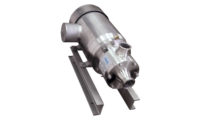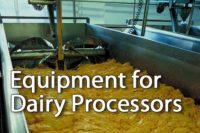Pumps and valves meet processor demands for safer and more efficient plants
The quest for more potent operating systems is leading to design enhancements.

Process control valves manage the flow rate of liquids. Photo courtesy of Burkert Fluid Control Systems.
The ever-evolving quest by dairy processors to maximize plant safety and efficiency is powering pumps and valves towards the top of the equipment hierarchy.
The components that move product and regulate the flow and pressure of operating systems are becoming increasingly vital and leading suppliers to create more reliable and effective designs, which is resulting in greater throughput, less processor downtime, and safer products.
Indeed, developers are designing equipment that meet specific processor objectives, such as energy and water savings, or easier servicing. Operators seeking to garner such benefits, however, must leverage the selections that are optimal for their specific situations.
“Pumps and valves are the heart of a system that keeps everything moving as it should,” says Chris Sinutko, global director of product management for nutrition and health for SPX Flow Inc., a Charlotte, N.C.-based pumps and valves supplier. “It is of utmost importance that the right selection is made during the designs.”
Processors should base their pump selection on such factors as product viscosity, sensitivity, flow rates, temperature, and pressure, says Randy Verges, senior applications engineer for Middleton, Wis.-based Fristam Pumps USA.
Temperature and pressure also are important when considering the optimal valves, along with chemical properties, states Sandra Schiller, head of sub-BU process automation and global product management, BU industry, for GF Piping Systems, a Schaffhausen, Switzerland-based valves supplier.
She notes, for instance, that while operators typically use stainless steel valves in supporting glycol and chilled water loops, DI water treatment and supply and wastewater plastic valves often are a viable option due to the components’ anti-corrosion and lightweight features.

Insulation on valves can deteriorate over time because of corrosion and ice build-ups, leading to inoperability, adds Angela Sampaio, GF Piping Systems’ business development manager cooling — USA.
“Plastic valves are a great and durable alternative when pressure and temperature allow for it and users are dealing with harsh chemicals,” Schiller states.
Cleanability is fundamental
Processors should seek components that are designed for maximum cleanability to prevent bacterial growth and product contamination while minimizing energy and waste during clean-in-place (CIP) operations. It also is important to have valves that are easier to access and dismantle for cleaning when CIP operations are not possible, notes Jochen Sprung, head of sales and business development for the food industry at Coperion GmbH, a Stuttgart, Germany-based valves supplier.
CIP systems, however, can save time and money and enable processors to reduce the risk of external contamination by using components that can be cleaned without the need for dismantling, he states. “Hygienic design and execution are key factors when selecting valves for dairy applications,” Sprung says.
Quality and pricing are important considerations as well when analyzing potential equipment, says Shianna Gracyalny, inside sales associate for Koss Industrial Inc., a Green Bay, Wis.-based pumps and valves supplier.

“The cheapest option may not [actually] be the cheapest in the long run,” she states, noting that more expensive systems often have upgrades that can save operators time, money, and such resources as water, energy or product. “The technologies should be considered an investment, and in the end, you get what you pay for,” she explains.
It is crucial, meanwhile, that designs are application specific, SPX Flow’s Sinutko states, noting, for instance, that the components must maintain product texture and body when supporting a highly viscous and fragile dairy item such as yogurt.
“Pumps and valves play a critical role in maintaining consistent product quality by controlling the flow and pressure of the product throughout processing operations,” he says. “Each product demands a specialized selection of pump and valve so the physicochemical properties, viscosity or chemicals are not altered in an unfavorable way during processing.”
The pumps and valves that dairy processors incorporate also can vary in accordance with federal and state regulations governing food safety, sanitation, and environmental protection, Sinutko says.
A plethora of possibilities
“There is a wide range of applications for vacuum pumps, from milking cows to packaging products, and each has different requirements and considerations,” notes Lars Heckersbruch, business development manager for Cuyahoga Falls, Ohio-based Becker Pumps Corp. “Over the last few decades, modern manufacturing processes and general technical improvements have made pumps more robust, efficient and less maintenance intensive. But suitable one-size-fits-all solutions for vacuum requirements exist in very few cases and finding someone with extensive vacuum knowledge is difficult.”
Vacuum pumps should provide the necessary vacuum level and gas flow rate and be able to handle the process vapors and operating environment, says VJ Gupta, product marketing manager for Busch LLC, a Virginia Beach, Va.-based vacuum pump supplier.
The optimal vacuum pump design can vary in accordance with how the equipment is used, Gupta says. He notes, for instance, that an evaporation or drying application where the process vapors are full of excessive moisture or water is best supported by a liquid ring vacuum pump, whereas an efficient dry-running vacuum pump could be sufficient for a forming application on a cheese tower consisting of much lower moisture levels.
Pump and valve designs, meanwhile, are rapidly evolving to keep pace with changing operator requirements. “As dairy processors strive for maximized product quality and seek to extract more from each measured unit of raw material, the demand on the systems used to produce these products is ever increasing,” relays Jim Larsen, field segment manager with Burkert Fluid Control Systems, a Huntersville, N.C.-based supplier of pumps and valves. “System parameters are being monitored more closely, which in turn, requires equipment capable of responding quickly, accurately, and with a high degree of repeatability.”
Such needs include having components that can withstand high temperatures, Sinutko notes. For instance, pasteurizing milk may necessitate systems that can operate at more than 212 degrees Fahrenheit for extended periods, he adds.
Along with pinpointing and leveraging the most functional components, processors often face the challenge of being able to promptly access the necessary equipment for their specific situations, Fristam Pumps’ Verges says. “It can be difficult to respond quickly to the new demands because the process of design, then prototype testing, and release to production, can easily entail a year or more,” he notes.

Testing is crucial as new processes are being developed where the flow and pressure requirements exceed what is currently available in sanitary pump technology. Therefore, there is a continuing need to increase the capacity to produce more milk daily, Verges notes. “We see this in the request for equipment to meet the higher flow rates in receiving bays, pasteurizers, and filtration equipment,” he states.
Plan for the future
Because the lead times for obtaining pumps and valves can be lengthy, Koss Industrial’s Gracelyn suggests processors start thinking about their needs “sooner rather than later,” and to have backup plans for accessing crucial components at short notice.
“Often, we see customers reach out just before a pump or valve is on its last leg and find themselves in a pinch trying to get a replacement on hand or on order,” she states. “Setting yourself up to have a ‘spare’ or thinking ahead on the ‘what ifs’ can help.”
Indeed, some processors are creating risk by using a single vacuum pump, Gupta says. “Which means if the pump is down for maintenance or otherwise, the machine cannot operate,” he notes.
Disposal or treatment of used process water or oil can be another operating obstacle, Busch’s Gupta says. If that’s the case, operators can consider switching to a dry-running vacuum pump to solve the issue.
Yet, along with incorporating effective pumps and valves, processors also must ensure they have the process controls in place to maintain efficiency and product quality, Burkert Fluid Control Systems’ Larsen says.
State-of-the-art systems can streamline energy use and increase productivity through improved monitoring and controls that provide real-time diagnostics on valve health to eliminate the unplanned downtime that can yield lost product, SPX Flow’s Sinutko says.
Valves also are incorporating position sensors that provide users with warnings if the components are blocked, he states. Valve usage parameters also can be set to trigger alarms once they have reached a certain number of hours or usage cycles or are becoming slower to respond.
“These signals allow for better process control, proactive maintenance, and less downtime,” Sinutko says, which, in a dairy plant, can result in a 1% to 3% loss reduction that saves of thousands of dollars per day.

Additionally, valves are becoming more functional by supporting greater data collection through position feedback and remote monitoring capabilities, GF Piping Systems’ Schiller states, noting that such elements are creating a path from preventive to predictive maintenance.
“Due to specific concerns on food safety, design options also can detect such issues as the possibility of metal wear or contaminants in their product or process,” Sprung adds. “Unintended contact between the rotary valve rotor and housing can occur because of improper operating conditions, including excessively high temperatures or high pressures; foreign bodies entering the rotary valve; and bearing damage or non-appropriate mounting or maintenance of the valve.”
Additional technologies, such as variable speed drives, also are creating more efficient processing systems by allowing pumps to operate at the exact flow rate and pressure requirement for the specific application, Sinutko states.
“Precise control of steam, glycol, air, and other media are the foundation for the manufacture of consistent, high-quality dairy products,” Burkert Fluid Control Systems’ Larsen concludes.
“System components designed for superior control accuracy, responsiveness, longevity, and adaptability to current automation platforms afford the level of control and reliability required by today’s hygienic process systems.”
Looking for a reprint of this article?
From high-res PDFs to custom plaques, order your copy today!





